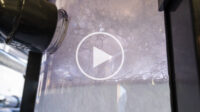Video: New Mass Balance Method for PFAS Measurement Exhibited at RemTEC & EC Summit
Using several different measurements, Ned Antell, staff scientist at Remedy Scientific Inc., shows a mass balance for PFAS
Based in the Bay Area of San Francisco, California, Ned Antell of Remedy Scientific is laser focused on soil remediation – treating high concentration PFAS contamination zones, like military bases and airports that used AFFF firefighting foam.
Key to understanding the efficacy of Remedy Scientific’s remediation efforts are alternative data sources.
The American Council of Governmental Industrial Hygienists has standards for inhalation exposures, but these don't directly cover ingestion or dermal contact. This, then, necessitates proxies to measure PFAS concentrations in soil and groundwater to gauge acceptable levels of exposure for construction workers.
“We are using techniques like traditional targeted analysis, like you might see for EPA method 1633, we're also measuring ultra-short PFAs to make sure that we're not creating undesirable transformation products. We're also putting in a significant amount of effort into measuring PFAs in the gas phase, so volatile PFAs, and this is a pretty new space from an analytical chemistry perspective that we are excited to tackle.”
He said they’re also using using NMR to measure both organ total organic fluorine, as well as inorganic fluoride.
“With all of these different analytical tools together, we can start to piece together a mass balance to really establish concrete evidence that we are bringing PFAS all the way to fluoride and not creating any volatile or ultrashort chain PFAS that are just going to be a problem down the line,” Antell concluded. “There's no silver bullet tool for measuring all PFAs so we kind of have to like measure chunks of it using all these different tools, and as a whole, we get a more accurate picture.”


.jpg?height=200&t=1664910248&width=200)

